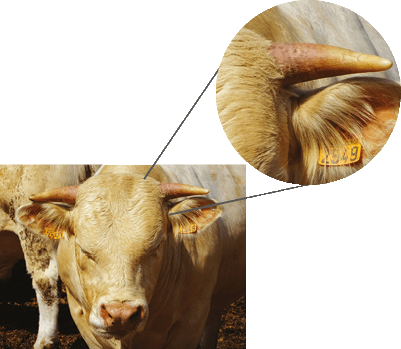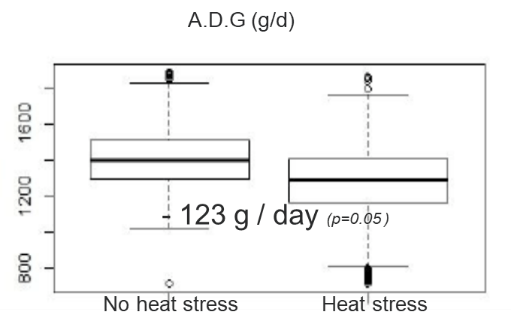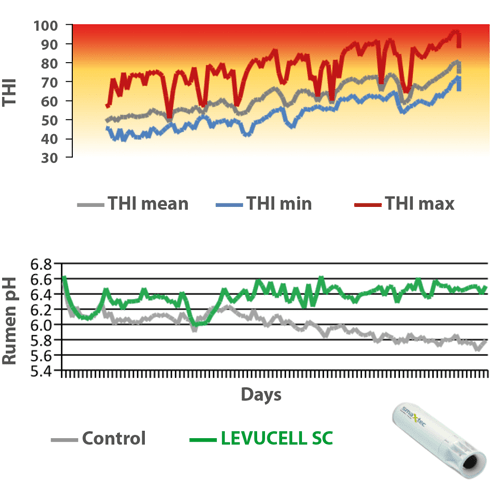Blog | Reading Time 5 minutes
How can live yeast visibly help reduce the impact of heat stress on beef cattle?
In dairy cows, the impact of heat stress can be easily measured by its effects on milk production and through many physiological or behavioral indicators. In beef cattle, the signs of heat stress are much less published and communicated. However, fattening cattle suffer just as much as dairy cows in warm temperatures. Around 25°C and higher, the animal immediately decreases its feed intake, which then takes several days to stabilize again, even at lower temperatures. The animals increase their respiratory rate and use up energy to dissipate excess heat, which contributes to a significant increase in maintenance needs. As a consequence, performance — but also health — are affected.
How to assess heat stress in beef cattle?
The temperature-humidity index, or THI, is a common indicator of heat stress risk level (Figure 1). This means that not only temperature is important but also the relative humidity level, which exacerbates the effect of heat. For beef cattle, the heat stress threshold is estimated at 72 (the orange zone in the THI table). This means that, for example, at 50% humidity, cattle suffer from heat stress starting at 25°C. Bear in mind that the THI reported by weather monitoring stations often underestimates the situation inside a barn, especially in terms of humidity. By placing a thermo-hygrometer or new generation of sensors that continuously monitor THI within the barn, producers can monitor and anticipate heat stress risks. The negative impact of heat stress is linked to the THI level but also to the duration of exposure, both in terms of the number of hours/day and the number of consecutive days of stress.
Susceptibility to heat stress also depends on genetic traits. For example, breeds with a dark coat suffer more than breeds with light coat color. Bos indicus breeds experience similar, but less pronounced, physiological changes during heat stress than Bos Taurus breeds for instance. The fat layer of cattle also plays the role of a thermal shield, slowing down the dissipation of heat.
Animal observation is key to assess the heat stress situation, and common indicators of moderate heat stress include:

Figure 2: Inflammation of the horns is due to histamine release and can be an indicator of poor rumen function.
- Shallow breathing
- Increased respiration rate
- Profuse sweating
Indications of severe heat stress in an animal include lethargic behavior, open mouths, and breathing with panting and tongue hanging out.
What happens under heat stress?
Heat stress challenges normal feeding behavior, metabolism, oxidative status, digestive health, as well as rumen pH and microbiota, leading to:
- Reduced feed intake
- Erratic feeding behavior decreased meal size and frequency
- Reduced rumination
- Low cleanliness and rumen fill
- Liquid manure
- Inflammation, visible in the horns and the hooves (Figure 2)
- Decreased lying time, which can lead to lameness and the appearance of “nervous” animals

Figure 3: ADG repartition of 8,129 beef in one farm raised between 2010 and 2016 in North East France. (Hervé, 2019)
The negative effects of heat stress are translated into a decreased average daily gain (ADG), and decreased herd homogeneity. A recent doctoral thesis research project (Hervé, 2019) conducted on 8,129 beef cattle shows a long-term depression of growth of about 10% when the THI is superior to 74 for only three consecutive days (THI 74 equivalent to >28°C, 60% humidity) as compared to animals raised in winter and spring (Figure 3).
Lallemand Animal Nutrition has developed a holistic approach to assess rumen efficiency of beef and dairy cattle based on visible indicators: the Rumen Efficiency Investigation (REI) program. All these animal criteria are evaluated as part of this program.
Benefits of rumen specific yeast
Nutritional strategies under heat stress should focus on supporting nutrient utilization by optimizing diet digestion while preserving rumen pH and function. In this context, the rumen specific live yeast Saccharomyces cerevisiae CNCM I-1077 (LEVUCELL SC) — demonstrated to benefit both nutrient digestion and rumen efficiency in ruminants — has been shown as an efficient nutritional tool to help maintain animal performance under heat stress.
A study conducted in Italy (2015) on a commercial farm with Charolais cattle showed a 5% increase in ADG under a THI around 70 when the animals received S. cerevisiae CNCM I-1077 as compared to controls.
Moreover, this study used a pH bolus system, which allows the measurement of the ruminal pH in real-time. It confirmed that rumen pH decreases in conditions of heat stress and is linked to the strong variations of feed intake and loss of saliva buffering capacity (panting).
S. cerevisiae CNCM I-1077 helps stabilize rumen pH, especially as the animal is in a heat stress condition (Figure 4).
Another trial was conducted at Texas A&M AgriLife Research in 2015 on 72 crossbred steers for 72 days. Diet was 90% concentrate, 10% hay with an average THI of 78 (minimum THI was 68, maximum THI was 90).
In this heat stress situation, the addition of S. cerevisiae CNCM I-1077 to the diet led to:
- More stable rumen pH with less daily individual changes
- Maintained feed intake
- More regular feeding behavior during the day, while animals not receiving LEVUCELL SC consumed feed more erratically during cooler periods
As a result, ADG of live yeast fed animals was 50 g higher compared to control animals, and the carcass weight 5 kg higher over the fattening period (70 days) with a highly acidogenic diet.
This research — combined with anecdotal experience from beef cattle operations across the world — demonstrates the use of a ruminant specific live yeast that is well documented for its stabilizing effects on ruminal pH is effective under challenging conditions to help stabilize rumen pH. It allows the consequences of heat stress on feed intake and growth performance to be minimized and offers high ROI to the producers.
Hervé Mathilde. 2019. Impact du stress thermique sur la croissance des taurillons : étude rétrospective auprès de 30 élevages en Alsace, DVM Thesis, UNiversity of Lyon, France
Lallemand Animal Nutrition internal data. 2015. Commercial farm, Italy.
Lallemand Animal Nutrition internal data. 2015. Texas A&M AgriLife, USA.
Published Jun 18, 2020 | Updated May 30, 2023
Related articles
Need specific information?
Talk to an expert
